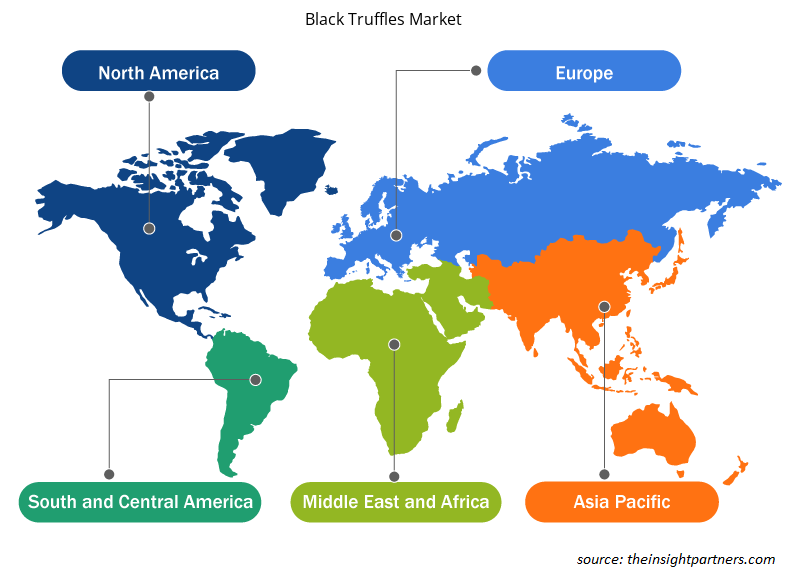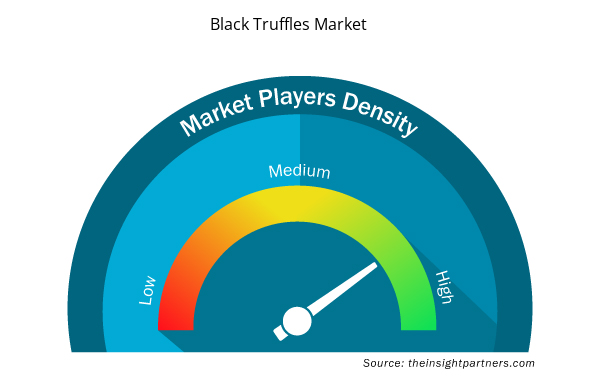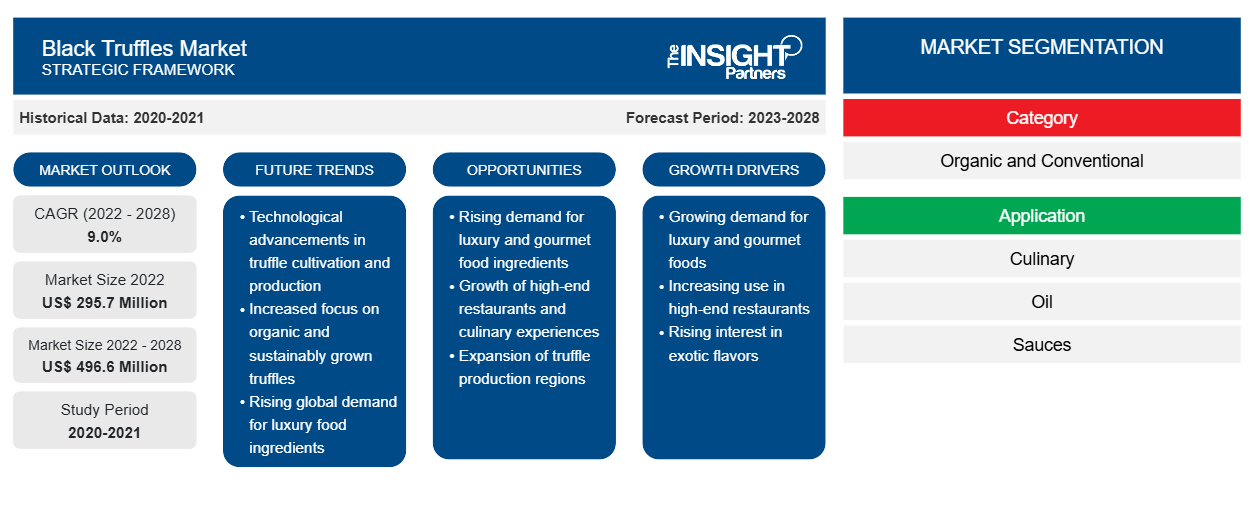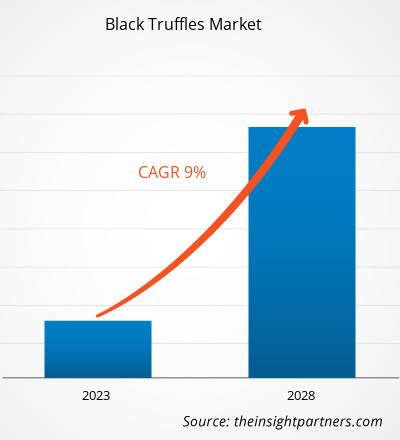Se proyecta que el tamaño del mercado de trufas negras crecerá de US$ 295,7 millones en 2022 a US$ 496,6 millones en 2028; se espera que crezca a una CAGR del 9,0% entre 2022 y 2028.
La trufa negra (Tuber melanosporum), también conocida como trufa de Perigord o trufa negra de invierno, se encuentra de forma silvestre en toda Europa desde noviembre hasta febrero, aunque la temporada puede variar ligeramente. Recientemente, la trufa negra de invierno se ha cultivado con éxito en Australia y Nueva Zelanda. Las trufas negras son hongos ectomicorrízicos, por lo que suelen encontrarse en estrecha asociación con las raíces de los árboles. Las trufas negras se utilizan principalmente en la cocina italiana y francesa. Las trufas negras tienen sabores y aromas únicos. El sabor de la trufa negra tiene notas terrosas con un toque de menta, pimienta y avellana. Las trufas negras son las preferidas por muchos gourmets debido a su perfil de sabor único. A menudo, los chefs llaman a la trufa negra el "diamante de la cocina".
Impacto de la pandemia de COVID-19 en el mercado de la trufa negra
En 2020, varias industrias tuvieron que reducir la velocidad de sus operaciones debido a las interrupciones en las cadenas de valor y suministro causadas por el cierre de las fronteras nacionales e internacionales. La pandemia de COVID-19 afectó negativamente a las economías y las industrias debido a los confinamientos, las prohibiciones de viaje y los cierres de empresas. Las interrupciones en las cadenas de suministro de materias primas clave y las irregularidades en los procesos de fabricación debido a las restricciones impuestas por las autoridades gubernamentales tuvieron un impacto directo en la industria de alimentos y bebidas. Estos factores afectaron negativamente al mercado de trufas negras durante la pandemia de COVID-19. Sin embargo, en 2021, el mercado fue testigo de una recuperación positiva cuando los gobiernos anunciaron la relajación de las restricciones impuestas anteriormente. A los fabricantes se les permitió trabajar a plena capacidad, aprovechando su rentabilidad. Se espera que este factor impulse el mercado en los próximos años.
Personalice este informe según sus necesidades
Obtendrá personalización en cualquier informe, sin cargo, incluidas partes de este informe o análisis a nivel de país, paquete de datos de Excel, así como también grandes ofertas y descuentos para empresas emergentes y universidades.
- Obtenga las principales tendencias clave del mercado de este informe.Esta muestra GRATUITA incluirá análisis de datos, desde tendencias del mercado hasta estimaciones y pronósticos.
Perspectivas del mercado
Iniciativas de innovación de productos por parte de los usuarios finales
Los fabricantes de trufa negra están invirtiendo significativamente en investigación y desarrollo, asociaciones y colaboraciones para lanzar productos innovadores que atraigan a una gran base de consumidores. Los vendedores de alimentos y bebidas están lanzando nuevos productos a base de trufa, como salsas y aceites, que impulsan el consumo de trufas negras en el mercado global. En 2018, deRosario, el fabricante con sede en EE. UU., lanzó una gama de condimentos de trufa elaborados con trufas, incluido el aceite de trufa negra y el aceite de oliva virgen extra. En 2020, PS Gourmet Pe lanzó su aceite de trufa negra en Singapur. En noviembre de 2022, TRUFF, un fabricante con sede en Australia, ingresó al espacio de los condimentos con "TRUFF Black Truffle Salt". La opción de condimento presenta una mezcla de sal marina fina y gruesa con una cantidad determinada de trufas negras. Estos lanzamientos de productos ayudan a las empresas a establecer relaciones a largo plazo con los consumidores finales.deRosario, the US-based manufacturer, launched a range of truffle Pe launched its black truffle oil in Singapore. In November 2022, TRUFF, an Australia-based manufacturer, entered into the seasoning space with "TRUFF Black Truffle Salt." The condiment option features a mix of fine and coarse sea salt with a purposeful amount of black truffles. Such product launches help companies establish long-term relationships with end-use consumers.
Tipo de información
Según la categoría, el mercado de trufas negras se segmenta en orgánico y convencional. Se proyecta que el segmento orgánico registre una CAGR más alta durante el período de pronóstico. La trufa negra orgánica se cultiva en suelo libre de fertilizantes químicos (como nitrógeno sintético, fosfato y potasa) e ingredientes modificados genéticamente. Los herbicidas y pesticidas sintéticos también se evitan en el cultivo de trufa negra orgánica. En su lugar, los productores utilizan estimuladores de crecimiento orgánicos para cultivar trufas negras orgánicas. En general, las trufas negras orgánicas son más caras que las trufas convencionales debido a su calidad superior. Las empresas se están centrando en lograr certificaciones orgánicas para abordar la creciente demanda de trufas negras orgánicas en el mercado.CAGR during the forecast period. Organic black truffle is cultivated in soil free from chemical fertilizers (such as synthetic nitrogen, phosphate, and potash) and genetically modified ingredients. Herbicides and synthetic stimulators to cultivate organic black truffles. Generally, organic black truffles are more expensive than conventional truffles due to their superior quality. Companies are focusing on achieving organic certifications to address the rising demand for organic black truffles in the market.
Información sobre aplicaciones
Según la aplicación, el mercado de las trufas negras se segmenta en culinario; aceite; salsas, cremas para untar y mantequilla; y otros. El segmento culinario tuvo la mayor participación del mercado en 2021. Las trufas negras se rallan en salsas a base de vino o crema o se raspan sobre pasta cocida, huevos revueltos o platos de papa. Las trufas negras se agregan como aderezo a varios productos alimenticios para mejorar su sabor y darles una apariencia más opulenta. Además, las trufas negras se agregan como ingredientes de guarnición a las comidas de carne y para dar un sabor fuerte a la comida. También se utilizan para producir sal de trufa y miel de trufa. Algunos tipos de quesos especiales también contienen trufas negras. Estos factores están impulsando la demanda de trufas negras en aplicaciones culinarias.
Los principales actores que operan en el mercado de trufas negras incluyen Trufo, TRUFFUS SAS, L'Aragonais Food Supplies SL, SABATINO NA LLC, LAUMONT TRUFFLES SLU, Arotz SA, Les Freres Jaumard SaRL, Perigord Truffles of Tasmania Pty Ltd, Great Southern Truffles Pty Ltd y Old World Truffles. Estos actores se centran en proporcionar productos de alta calidad para satisfacer las demandas de los clientes. También se centran en estrategias como inversiones en actividades de investigación y desarrollo y lanzamientos de nuevos productos.
Perspectivas regionales del mercado de trufas negras
Los analistas de Insight Partners han explicado detalladamente las tendencias y los factores regionales que influyen en el mercado de trufas negras durante el período de pronóstico. Esta sección también analiza los segmentos y la geografía del mercado de trufas negras en América del Norte, Europa, Asia Pacífico, Oriente Medio y África, y América del Sur y Central.

- Obtenga los datos regionales específicos para el mercado de trufas negras
Alcance del informe sobre el mercado de trufas negras
| Atributo del informe | Detalles |
|---|---|
| Tamaño del mercado en 2022 | US$ 295,7 millones |
| Tamaño del mercado en 2028 | US$ 496,6 millones |
| CAGR global (2022-2028) | 9.0% |
| Datos históricos | 2020-2021 |
| Período de pronóstico | 2023-2028 |
| Segmentos cubiertos | Por categoría
|
| Regiones y países cubiertos | América del norte
|
| Líderes del mercado y perfiles de empresas clave |
|
Densidad de actores del mercado de trufas negras: comprensión de su impacto en la dinámica empresarial
El mercado de las trufas negras está creciendo rápidamente, impulsado por la creciente demanda de los usuarios finales debido a factores como la evolución de las preferencias de los consumidores, los avances tecnológicos y una mayor conciencia de los beneficios del producto. A medida que aumenta la demanda, las empresas amplían sus ofertas, innovan para satisfacer las necesidades de los consumidores y aprovechan las tendencias emergentes, lo que impulsa aún más el crecimiento del mercado.
La densidad de actores del mercado se refiere a la distribución de las empresas o firmas que operan dentro de un mercado o industria en particular. Indica cuántos competidores (actores del mercado) están presentes en un espacio de mercado determinado en relación con su tamaño o valor total de mercado.
Las principales empresas que operan en el mercado de la Trufa Negra son:
- Trufo, Truffus SAS
- Suministros Alimentarios L'aragonais SL
- Sabatino Na LLC
- Trufas Laumont SLU
- Arotz SA
Descargo de responsabilidad : Las empresas enumeradas anteriormente no están clasificadas en ningún orden particular.

- Obtenga una descripción general de los principales actores clave del mercado de trufas negras
Informe Destacado
- Tendencias progresivas de la industria en el mercado de trufas negras para ayudar a los actores a desarrollar estrategias efectivas a largo plazo
- Estrategias de crecimiento empresarial adoptadas por las empresas para asegurar el crecimiento en los mercados desarrollados y en desarrollo
- Análisis cuantitativo del mercado de trufa negra de 2019 a 2028
- Estimación de la demanda mundial de trufas negras
- Análisis de las cinco fuerzas de Porter para ilustrar la eficacia de los compradores y proveedores de trufas negras
- Avances recientes para comprender el escenario competitivo del mercado
- Tendencia y perspectivas del mercado, junto con los factores que impulsan y restringen el crecimiento del mercado de trufas negras
- Asistencia en el proceso de toma de decisiones destacando las estrategias de mercado que sustentan el interés comercial.
- El tamaño del mercado de trufas negras en varios nodos
- Descripción detallada y segmentación del mercado, así como de la dinámica de la industria de alimentos y bebidas.
- Tamaño del mercado de trufas negras en diversas regiones con prometedoras oportunidades de crecimiento
Perfiles de empresas
- Trufo
- TRUFFUS SAS
- Suministros Alimentarios L'Aragonais SL
- SABATINO NA LLC
- TRUFAS LAUMONT SLU
- Arotz SA
- Los Hermanos Jaumard SaRL
- Trufas de Perigord de Tasmania Pty Ltd
- Grandes trufas del sur Pty Ltd
- Trufas del Viejo Mundo
- Análisis histórico (2 años), año base, pronóstico (7 años) con CAGR
- Análisis PEST y FODA
- Tamaño del mercado Valor/volumen: global, regional, nacional
- Industria y panorama competitivo
- Conjunto de datos de Excel



Report Coverage
Revenue forecast, Company Analysis, Industry landscape, Growth factors, and Trends

Segment Covered
This text is related
to segments covered.

Regional Scope
North America, Europe, Asia Pacific, Middle East & Africa, South & Central America

Country Scope
This text is related
to country scope.
Preguntas frecuentes
Wide application scope of black truffles is driving the black truffles market. Black truffles are in high demand among food processing industries as black truffle is an essential ingredient in premium packaged food products, including black truffle-infused oil, cheese, honey, and sauces. TRUFF, the Australia-based manufacturer, provides black truffle oil, pasta sauce, mayo, hot sauce, and black truffle salt. Moreover, black truffles are used for household purposes as people are willing to prepare gourmet food with different luxury ingredients. Furthermore, black truffle usage is not limited to food and beverage products; it is also used in cosmetic products, including moisturizers, night creams, antiaging formulas, etc. Therefore, the rising usage of black truffles in various applications propels the growth of the global black truffles market.
Based on the application, oil segment is projected to grow at the fastest CAGR over the forecast period. Black truffle oil is a modern culinary ingredient used to impart the flavor and aroma of truffles to a dish. Common versions use olive oil or more neutral flavorless oils such as canola or grapeseed oil. Black truffle oil is used as a finishing oil in various dishes, including truffle fries, pizzas, pasta dishes, and puréed foods such as mashed potatoes and deviled eggs. Black truffle oil is available in all seasons and is significantly less expensive than fresh truffles. Thus, manufacturers are launching truffle oils to fulfill the increasing demand.
Europe accounted for the largest share of the global black truffles market. There is a growing demand for natural ingredients in the European cosmetics sector, creating opportunities for cosmetics processors and processors of black truffle oil, spreads, and sauces from developing countries such as India, Australia, Indonesia, and China. Black truffle oil, spreads & sauces in the food industry, have several functional and active properties as it is heart-healthy, fat-free. Also, creams & lotions incorporated with black truffles in the cosmetic industry possess antioxidant properties, boosting their application in various formulations. Hence, the demand for black truffles is expected to continue to rise in the coming years in Europe.
Based on category, conventional segments mainly have the largest revenue share. Synthetic fertilizers, pesticides, insecticides, herbicides, and fungicides are used in conventional black truffle farming. Genetically modified organisms or crop varieties used by growers deliver consistent yields. Conventionally grown black truffles are cheaper than organic ones. However, using chemicals and fertilizers in conventional farming primarily affects health and the nutrient levels of the yield. As a result, the popularity of organic products is growing notably due to their high quality and sustainability. On the other hand, manufacturers may continue to use conventional black truffles owing to their affordability and easy availability.
The major players operating in the global black truffles market are Trufo, Truffus SAS, L'aragonais Food Supplies SL, Sabatino Na LLC, Laumont Truffles SLU, Arotz SA, Les Freres Jaumard Sarl, Perigord Truffles of Tasmania Pty Ltd., Great Southern Truffles Pty Ltd., Old World Truffles.
Growth of black truffles in emerging region to provide potential market opportunities in the coming years for the black truffles. The southwest corner of Western Australia has become the "hot spot" for truffle production across the world. There are now more than 70 growers with plantations of sufficient size and becoming commercial producers of the French black truffle. Therefore, the expansion of black truffles in emerging regions is expected to offer lucrative opportunities for the black truffle market during the forecast period.
Trends and growth analysis reports related to Food and Beverages : READ MORE..
The List of Companies - Black Truffles Market
- Trufo, Truffus SAS
- L'aragonais Food Supplies SL
- Sabatino Na LLC
- Laumont Truffles SLU
- Arotz SA
- Les Freres Jaumard Sarl
- Perigord Truffles of Tasmania Pty Ltd.
- Great Southern Truffles Pty Ltd.
- Old World Truffles
The Insight Partners performs research in 4 major stages: Data Collection & Secondary Research, Primary Research, Data Analysis and Data Triangulation & Final Review.
- Data Collection and Secondary Research:
As a market research and consulting firm operating from a decade, we have published and advised several client across the globe. First step for any study will start with an assessment of currently available data and insights from existing reports. Further, historical and current market information is collected from Investor Presentations, Annual Reports, SEC Filings, etc., and other information related to company’s performance and market positioning are gathered from Paid Databases (Factiva, Hoovers, and Reuters) and various other publications available in public domain.
Several associations trade associates, technical forums, institutes, societies and organization are accessed to gain technical as well as market related insights through their publications such as research papers, blogs and press releases related to the studies are referred to get cues about the market. Further, white papers, journals, magazines, and other news articles published in last 3 years are scrutinized and analyzed to understand the current market trends.
- Primary Research:
The primarily interview analysis comprise of data obtained from industry participants interview and answers to survey questions gathered by in-house primary team.
For primary research, interviews are conducted with industry experts/CEOs/Marketing Managers/VPs/Subject Matter Experts from both demand and supply side to get a 360-degree view of the market. The primary team conducts several interviews based on the complexity of the markets to understand the various market trends and dynamics which makes research more credible and precise.
A typical research interview fulfils the following functions:
- Provides first-hand information on the market size, market trends, growth trends, competitive landscape, and outlook
- Validates and strengthens in-house secondary research findings
- Develops the analysis team’s expertise and market understanding
Primary research involves email interactions and telephone interviews for each market, category, segment, and sub-segment across geographies. The participants who typically take part in such a process include, but are not limited to:
- Industry participants: VPs, business development managers, market intelligence managers and national sales managers
- Outside experts: Valuation experts, research analysts and key opinion leaders specializing in the electronics and semiconductor industry.
Below is the breakup of our primary respondents by company, designation, and region:

Once we receive the confirmation from primary research sources or primary respondents, we finalize the base year market estimation and forecast the data as per the macroeconomic and microeconomic factors assessed during data collection.
- Data Analysis:
Once data is validated through both secondary as well as primary respondents, we finalize the market estimations by hypothesis formulation and factor analysis at regional and country level.
- Macro-Economic Factor Analysis:
We analyse macroeconomic indicators such the gross domestic product (GDP), increase in the demand for goods and services across industries, technological advancement, regional economic growth, governmental policies, the influence of COVID-19, PEST analysis, and other aspects. This analysis aids in setting benchmarks for various nations/regions and approximating market splits. Additionally, the general trend of the aforementioned components aid in determining the market's development possibilities.
- Country Level Data:
Various factors that are especially aligned to the country are taken into account to determine the market size for a certain area and country, including the presence of vendors, such as headquarters and offices, the country's GDP, demand patterns, and industry growth. To comprehend the market dynamics for the nation, a number of growth variables, inhibitors, application areas, and current market trends are researched. The aforementioned elements aid in determining the country's overall market's growth potential.
- Company Profile:
The “Table of Contents” is formulated by listing and analyzing more than 25 - 30 companies operating in the market ecosystem across geographies. However, we profile only 10 companies as a standard practice in our syndicate reports. These 10 companies comprise leading, emerging, and regional players. Nonetheless, our analysis is not restricted to the 10 listed companies, we also analyze other companies present in the market to develop a holistic view and understand the prevailing trends. The “Company Profiles” section in the report covers key facts, business description, products & services, financial information, SWOT analysis, and key developments. The financial information presented is extracted from the annual reports and official documents of the publicly listed companies. Upon collecting the information for the sections of respective companies, we verify them via various primary sources and then compile the data in respective company profiles. The company level information helps us in deriving the base number as well as in forecasting the market size.
- Developing Base Number:
Aggregation of sales statistics (2020-2022) and macro-economic factor, and other secondary and primary research insights are utilized to arrive at base number and related market shares for 2022. The data gaps are identified in this step and relevant market data is analyzed, collected from paid primary interviews or databases. On finalizing the base year market size, forecasts are developed on the basis of macro-economic, industry and market growth factors and company level analysis.
- Data Triangulation and Final Review:
The market findings and base year market size calculations are validated from supply as well as demand side. Demand side validations are based on macro-economic factor analysis and benchmarks for respective regions and countries. In case of supply side validations, revenues of major companies are estimated (in case not available) based on industry benchmark, approximate number of employees, product portfolio, and primary interviews revenues are gathered. Further revenue from target product/service segment is assessed to avoid overshooting of market statistics. In case of heavy deviations between supply and demand side values, all thes steps are repeated to achieve synchronization.
We follow an iterative model, wherein we share our research findings with Subject Matter Experts (SME’s) and Key Opinion Leaders (KOLs) until consensus view of the market is not formulated – this model negates any drastic deviation in the opinions of experts. Only validated and universally acceptable research findings are quoted in our reports.
We have important check points that we use to validate our research findings – which we call – data triangulation, where we validate the information, we generate from secondary sources with primary interviews and then we re-validate with our internal data bases and Subject matter experts. This comprehensive model enables us to deliver high quality, reliable data in shortest possible time.


 Obtenga una muestra gratuita de este informe
Obtenga una muestra gratuita de este informe